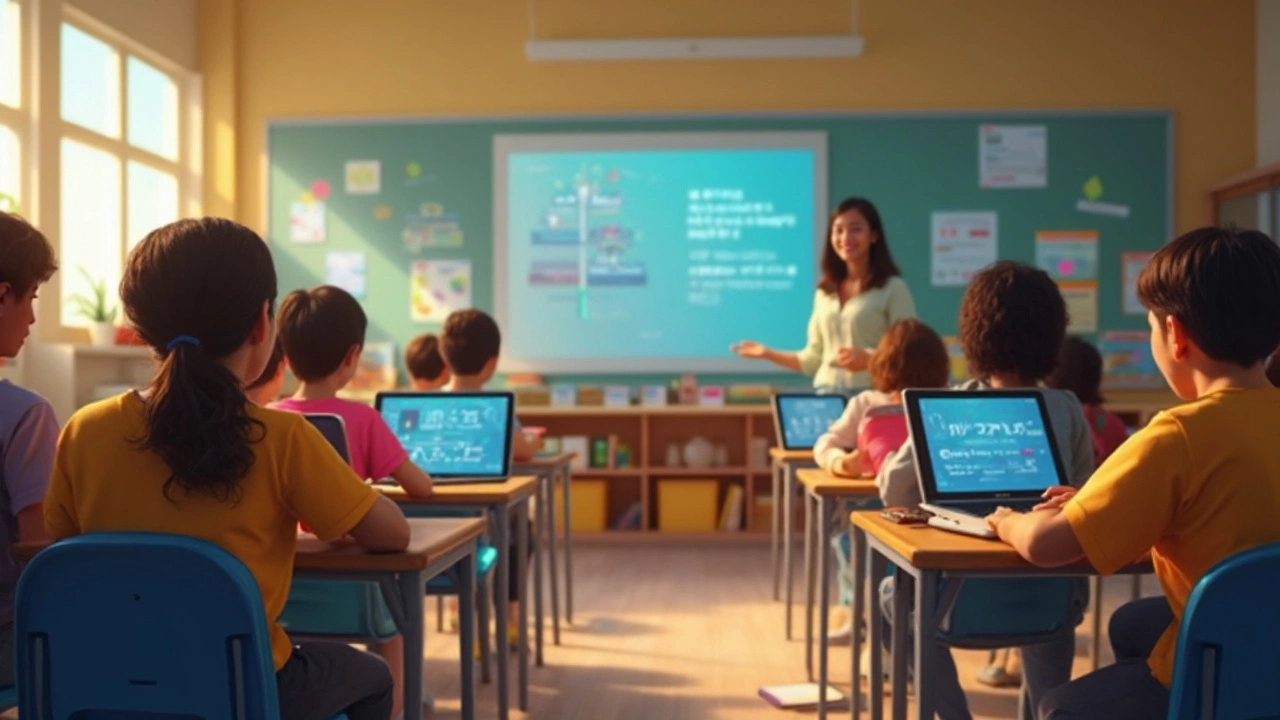Here’s something you might not hear from your old school counselor: distance learning isn’t just a backup plan for when you can’t get to campus. It’s actually changing how people learn, work, and climb up the career ladder. Ever tried to juggle a job, family, and personal time while commuting to a college two towns over? Distance learning cuts out that headache—and the gas bill.
The biggest draw? Flexibility. Log in from your couch, the library, or even a coffee shop. Classes and assignments fit your schedule, not the other way around. This means more folks can finish school, grab a better job, or learn a new skill while holding down the fort at home or work. And get this: A 2024 survey from the Pew Research Center found over 80% of online learners felt they could actually pay better attention compared to sitting in a packed lecture hall.
If time and money are always tight, distance learning can seriously lighten the load. No need for expensive commutes, pricey meal plans, or dorm rooms you’ll barely sleep in. Plus, digital textbooks and resources mean you spend less on supplies and more on, well, anything else.
- Learning Anywhere, Anytime
- Saving Money and Resources
- Boosting Digital Skills
- Balancing Life and Education
- Making the Most of Online Classes
Learning Anywhere, Anytime
The real game-changer with distance learning is having the freedom to learn on your terms. Whether you’re in a tiny apartment, a busy house, or traveling for work, all you need is a solid internet connection and a device. You decide when and where to hit the books, not some rigid school bell.
Remote study blew up for a reason—people just couldn’t always make it to a classroom. A 2023 report by EducationData.org showed that over 12 million people in the US were enrolled in fully online programs. Out of those, about 60% said being able to pick their own learning environment made sticking with school easier compared to traditional classes.
If you’re a night owl, online classes let you study when your brain’s actually awake. Early risers can finish work before lunch. Students with jobs or kids aren’t forced to choose between work shifts and study sessions. This flexible learning lets you fit education around real life, not the other way around.
- Travel for work or family? You won’t fall behind—just log on from wherever.
- Don’t want distractions? Choose a place that helps you focus, even if it changes each week.
- Courses work across time zones, so you’re not limited by where you live.
Check out this comparison to see how distance learning stacks up against the classroom when it comes to location and schedule:
| Flexibility Feature | Distance Learning | Traditional Classroom |
|---|---|---|
| Study Location | Anywhere with Internet | On-campus only |
| Class Times | Often on-demand | Fixed schedule |
| Catch-up Options | Rewatch lectures anytime | Ask for class notes |
The bottom line: distance learning puts you in the driver’s seat. It’s about learning in ways that actually fit your daily routine—so you’re more likely to stick with it and actually finish.
Saving Money and Resources
If you’ve ever looked at the cost of going to a regular college, you know that tuition is just the beginning. Once you add up gas or bus fare, parking, textbooks, and eating on campus, things get pricey fast. With distance learning, a lot of those costs drop right off the radar.
First off, you don’t need to move or pay for a dorm. The money you save by learning from home can go toward bills or even a new laptop—something you’ll actually use for your online classes. If you’re stressed about expenses, you’re definitely not alone; a 2023 report from EducationData.org showed the average student at a traditional campus spends over $2,000 a year just on transportation and on-campus meals. With online education, those costs are basically wiped out.
Textbooks are another big deal. Most distance education programs use digital textbooks or open-source materials, so you’re not shelling out hundreds a semester just to keep up. And with fewer printed materials, it’s better for the environment too.
- No dorm fees or moving costs
- Zero gas or bus fare for commuting
- Cheaper or free digital textbooks
- Less money spent on food away from home
Check this out:
| Expense | Traditional In-Person | Distance Learning |
|---|---|---|
| Transportation | $1,200/yr | $50/yr |
| Housing | $8,000/yr | $0 |
| Textbooks | $400/sem | $80/sem |
Add it up and the savings are hard to ignore. For people going back to school or starting fresh, distance learning can mean less stress about money and more focus on learning and career moves.

Boosting Digital Skills
Here’s something you can take straight to your next job interview: doing distance learning makes you sharper with digital tools. Every online class puts you in a spot where you have to use apps, solve tech hiccups, and navigate loads of different platforms. This isn’t just about logging onto Zoom. You learn stuff like sharing files in Google Drive, using project boards like Trello, or joining real-time web chats. These aren’t just “extra skills”—a lot of companies now expect you to already know them.
Check out this overview from a 2024 LinkedIn report: about 72% of employers said they were more likely to hire people who picked up new tech and online tools on their own. That’s because remote work, video calls, and digital document sharing aren’t going anywhere. You’ll already have a head start because distance learning forces you to solve problems and communicate just like in a remote-work job.
Here’s a quick look at the tech stuff you’ll pick up by studying online:
- Setting up and using online meeting software (Zoom, Teams, Google Meet)
- Organizing assignments with cloud drives (Google Drive, Dropbox)
- Collaborating with teams in real time using chat and project apps
- Managing your own digital calendar, deadlines, and notifications
- Sorting out basic tech issues like camera/mic setups or slow Wi-Fi
Not convinced? Peek at the table below to see how students rate their digital confidence before and after doing online education:
| Skill | Before Online Classes | After Online Classes |
|---|---|---|
| Using video calls | 43% | 92% |
| Cloud file sharing | 39% | 89% |
| Online teamwork | 35% | 85% |
Getting these skills isn’t just a happy accident—it’s baked right into every online course. So after graduation, handling digital stuff at your future job will feel like second nature. You’ll stand out without even breaking a sweat.
Balancing Life and Education
If you’ve ever tried working a job, taking care of family, and squeezing in class all at once, you know how tough it can get. That’s where distance learning pulls ahead. With online classes, you don’t have to show up at the same spot every week at a certain time. Instead, you can hit play on a lecture after your kids go to bed or tackle a quiz during your lunch break at work. It’s made for real-life schedules.
This isn’t just a random benefit. The National Center for Education Statistics found that over half of online students are working while studying—some even full-time. That means these folks are living proof that flexible learning lets you handle your responsibilities without putting your education on hold.
For parents, distance education is a lifesaver. You’re not scrambling for expensive childcare, and you can pause to handle emergencies without missing an entire class. Plus, college isn’t just for 18-year-olds; plenty of adults go back to school for a fresh start, a promotion, or a total career switch.
Here are a few tips for keeping things together while doing online education:
- Set a weekly calendar—block off time for classes, work, and downtime so you don’t burn out.
- Get your family or roommates on board—tell them when you’ll need quiet time for big assignments.
- Use apps or reminders to stay on track with deadlines and group tasks.
- Don’t be afraid to ask for help, either from professors or classmates, when life suddenly gets crazy.
| Stat | Traditional Classroom | Distance Learning |
|---|---|---|
| Students with Full-Time Jobs | 17% | 52% |
| Average Age | 21 years | 27 years |
Trying to do it all isn’t easy, but with remote study, you actually stand a better shot at keeping all the plates spinning. Your education fits around your life, not the other way around.

Making the Most of Online Classes
Whether you’re new to distance learning or just looking to up your game, a few tips can seriously boost your experience. It’s easy to get distracted when you’re not in a classroom, but some simple habits can make a big difference in how much you actually learn—and remember.
First off, treat your online classes like real ones. Get up at a set time, log in, and make learning part of your daily routine. Block out a quiet spot if you can—even if it’s just a corner with headphones.
- Create a study schedule: Use a calendar or a planner app to keep track of deadlines. Set reminders for quizzes, assignments, and live sessions.
- Stay connected with your teachers and classmates: Most platforms have forums, chats, or discussion boards. Asking questions when you’re stuck helps more than just scrolling through Google.
- Take regular breaks: Studies show that people who step away every 50–60 minutes come back better focused, especially with online education.
- Keep your tech in check: Test out video calls, update your laptop, and always have a charger handy. Nothing slows you down like tech issues mid-class.
One cool fact: In a 2024 Digital Learning Pulse survey, 72% of remote learners said having recorded lectures helped them learn at their own pace. They rewatched tricky parts, paused for notes, or sped up through stuff they already knew.
| Tip | Why it matters |
|---|---|
| Set clear goals | Helps you stay motivated and measure progress |
| Engage in discussions | Improves understanding and memory |
| Organize digital notes | Makes review faster and easier |
| Don’t multitask | Boosts focus during live sessions |
Remote study gives you more control—but it also puts you in charge of keeping yourself on track. Find what study methods click for you. Some folks swear by flashcards, others need mind maps, some like recorded voice notes. Try a few and stick with what feels easy—not forced. The more at home you get with flexible learning, the more it pays off.


